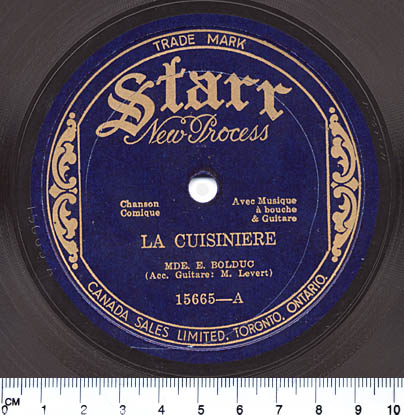- La Cuisinière
Infobox Single
Name = La Cuisinière

Cover size =
Caption =
Artist =La Bolduc ,Médart Levert
Album =
A-side =
B-side =
Released = March 1930
Format = 78 rpm
Recorded =December 6 ,1929
Genre = Quebecois Folk Music
Language = French
Length =
Label =Starr Records
Writer =
Producer =Roméo Beaudry
Certification =
Last single =
This single =
Next single =
Misc =La Cuisinière is a song written by
Mary Bolduc and released by theStarr Record Company on her fourth record, alongside "Johnny Monfarleau ".cite web|title = La Bolduc -- "The Queen of Canadian Folksingers"|url = http://www.collectionscanada.ca/gramophone/m2-1032-e.html|publisher = Collections Canada] Although it was her fourth release, this was her first record to achieve any commercial success.cite web|url = http://www.collectionscanada.ca/gramophone/m2-1033-e.html|title = La Bolduc -- Recording Career|publisher = Collections Canada] "La Cuisinière" was very successful, selling twelve thousand copies inQuebec , which was unprecedented sales for a record at the time. [cite web|url = http://www.collectionscanada.ca/women/002026-210-e.html|title = La Bolduc (Mary Travers)|publisher = Collections Canada] The success of the song made Bolduc a household name in Quebec.The song tells of the encounters of a domestic servant with various
suitor s. The overall tone is humorous.cite web|url = http://www.collectionscanada.ca/gramophone/m2-1038-e.html|title = La Bolduc -- A Musical Mirror of Canada's Heritage|publisher = Collections Canada] This follows a long tradition of French comedic folk songs dealing with rejected suitors. The lyrics are set in five versus, each of four lines. Each verse ends with the phrase: "Hourra pour la cuisinière". The general rhyming scheme isrhyming couplets , with the first two and second two lines of each verse rhyming. The last two lines do not rhyme, however.The
melody follows an AABC pattern, where A, B and C aremusical phrases that last four bars. Canadian folk songs of the time often employed 16 bar phrases such as this, and it would have been a common pattern in the Gaspé logging camps where Bolduc first performed publicly. The melody itself comes from a folk tune inAcadia . Thepitch range is a ninth, common for such folk songs.The song shows some influence from
broadside ballads , a traditional Irish song type. It has a very regular pattern that both the music and the lyrics follow. It also opens with the phrase "Je vais vous dire quelques mots" which is very similar to the traditional opening of broadside ballads, "O come ye listen to my story". The influence of French folk music can be seen in the use ofenumeration andassonance .References
External links
* [http://www.collectionscanada.ca/obj/m2/f3/13392.ram La Cuisinière]
Wikimedia Foundation. 2010.
